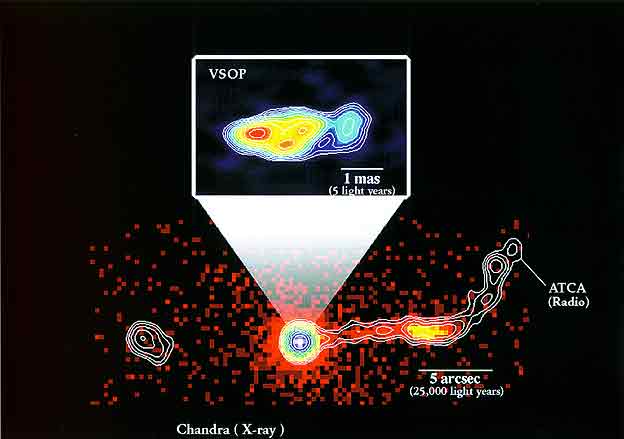The X-ray and radio jet of the quasar PKS0637-752
|
|---|
 The X-ray satellite Chandra was launched in the summer of 1999, and observed the quasar PKS 0637-752 as a point-source for in-orbit check-out and calibration. A VSOP observation at a wavelength of 6cm had already been made of this source, revealing a sub-milli-arcsecond scale radio jet. In order to understand the mechanism by which active galactic nuclei emit radiation from radio to X-rays, simultaneous observations are important. For this reason, at the time of the Chandra observation a second VSOP observation was made. Surprisingly, the Chandra observation revealed that the "point-source" in fact had an X-ray jet extending from the quasar core. Although the resolution is very different, the finer-scale VSOP image shows the radio jet points in the same direction as the X-ray jet.
The X-ray satellite Chandra was launched in the summer of 1999, and observed the quasar PKS 0637-752 as a point-source for in-orbit check-out and calibration. A VSOP observation at a wavelength of 6cm had already been made of this source, revealing a sub-milli-arcsecond scale radio jet. In order to understand the mechanism by which active galactic nuclei emit radiation from radio to X-rays, simultaneous observations are important. For this reason, at the time of the Chandra observation a second VSOP observation was made. Surprisingly, the Chandra observation revealed that the "point-source" in fact had an X-ray jet extending from the quasar core. Although the resolution is very different, the finer-scale VSOP image shows the radio jet points in the same direction as the X-ray jet.
 The Chandra image (the color pixels) has 0.5 arcsecond resolution, and shows a jet about 10 arcseconds (50,000 light years) long extending to the right. An image made with the Australia Telescope Compact Array (ATCA) superimposed as contours levels shows jet emission on both sides of the core, with the emission on the right matching the Chandra emission very well. The ATCA image shows the jet turns sharply about 10 arcseconds from the core, with the X-ray emission in the jet being brightest just before this bend. The 0.2 milli-arcsecond resolution VSOP image of the quasar core shows the jet extending to 3 milli- arcseconds (15 light years) from the core. The jet width may be the intrinsic width on this scale, or may possibly be due to a spiral-like nature of the jet. There is evidence that these jet components are moving with an apparent speed of about eleven times the speed of light -- indicating the jet is directed close to our line of sight to the quasar.
The Chandra image (the color pixels) has 0.5 arcsecond resolution, and shows a jet about 10 arcseconds (50,000 light years) long extending to the right. An image made with the Australia Telescope Compact Array (ATCA) superimposed as contours levels shows jet emission on both sides of the core, with the emission on the right matching the Chandra emission very well. The ATCA image shows the jet turns sharply about 10 arcseconds from the core, with the X-ray emission in the jet being brightest just before this bend. The 0.2 milli-arcsecond resolution VSOP image of the quasar core shows the jet extending to 3 milli- arcseconds (15 light years) from the core. The jet width may be the intrinsic width on this scale, or may possibly be due to a spiral-like nature of the jet. There is evidence that these jet components are moving with an apparent speed of about eleven times the speed of light -- indicating the jet is directed close to our line of sight to the quasar.
|
|

